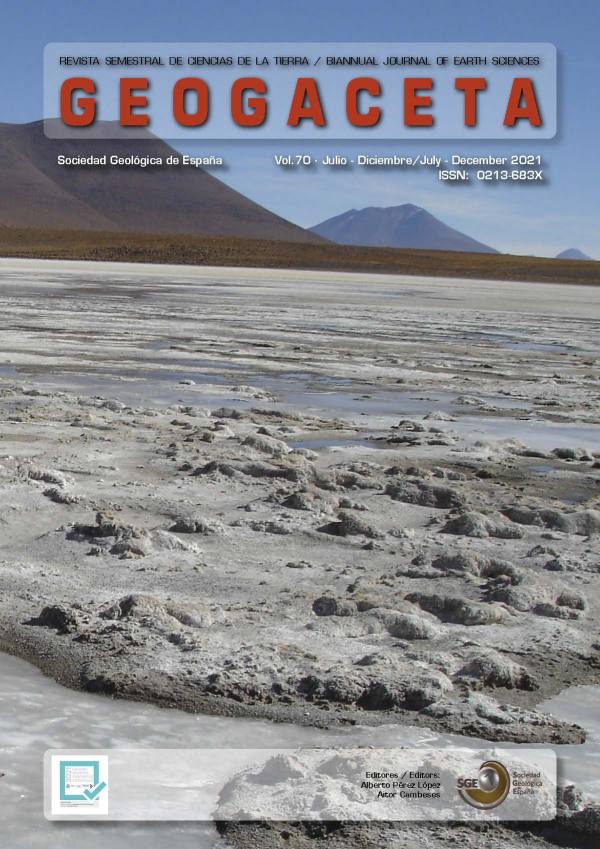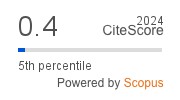Preliminary analysis of the determining factors of karst springs temperature in Andalusia
DOI:
https://doi.org/10.55407/geogaceta102295Keywords:
water temperature, karstic springs, thermal budgetAbstract
Water temperature in 40 springs that drain the most important karst massifs in Andalusia is between 9.8 and 27.5 °C; nevertheless, 75% of flow drained by these aquifers has a temperature from 12 to 18 °C. Water temperature is similar to the mean environmental temperature (lapse rate of -0.49 °C/100m), although there are small differences, often in the range of ± 3 °C. It is observed that springs located at higher elevations have colder waters than the environmental average, while springs that are at lower elevations, have waters relatively warmer. These variations would be related to the control exerted by different variables, such as geology, climate, the degree of karstification of materials and the rate of recharge, on the temperature of groundwater. Likewise, a preliminary thermal budget has been established, which considers the main sources of heat in the water and highlights the importance of air flow in heat transport in the vadose zone.
References
Anderson, M.P. (2005). Heat as a Ground Water Tracer. Ground Water, 43-6, 951-968. https://doi.org/10.1111/j.1745-6584.2005.00052.x
Badino, G. (2010). Underground meteorology: What's the weather underground? Acta Carsologica, 29-3, 427-448. https://doi.org/10.3986/ac.v39i3.74
Benavente, J., Pulido-Bosh, A., Fernández-Rubio, R. (1986). Les grands caractères de l'hydrogéologie karstique dans les Cordillères Bétiques. Karstologia Mémories, 1, 87-89.
Brookfield, A.E., Macpherson, G.L., Covington, M.D. (2017). Effects of Changing Meteoric Precipitation Patterns on Groundwater Temperature in Karst Environments. Ground Water, 55-2, 227-36. https://doi.org/10.1111/gwat.12456
Colmenar-Santos, A., Folch, M., Rosales, E., Borge, D. (2016). The geotermal potential in Spain, Renewable and Sustainable Energy Reviews, 56, 865-886. https://doi.org/10.1016/j.rser.2015.11.070
Luetscher, M., Jeannin, P.Y. (2004). Temperature distribution in karst systems: the role of air and water fluxes. Terra Nova, 16-6, 344-350. https://doi.org/10.1111/j.1365-3121.2004.00572.x
Manga, M., Kirchner, J.W. (2004). Interpreting the temperature of water at cold springs and the importance of gravitational potential energy. Water Resources Research, 40. https://doi.org/10.1029/2003WR002905
MAGRAMA (2013). Sistema de Información Geográfica de Datos Agrarios (SIGA). Ministerio de Agricultura y Pesca, Alimentación y Medio Ambiente, Madrid.
Moral, F. (2005). Contribución al conocimiento de los acuíferos carbonáticos de la Sierra de Segura (Alto Guadalquivir y Alto Segura). Tesis Doctoral, Univ. Pablo de Olavide, 580 pp.
Schöeller, H. (1962). Les eaux souterraines. Ed. Masson, Paris, 642 pp.
Downloads
Published
How to Cite
Issue
Section
License

This work is licensed under a Creative Commons Attribution-NonCommercial-ShareAlike 4.0 International License.
Until the year 2023 the author assigned the copyright to the Sociedad Geológica de España, but from 2024 the author retains the copyright and grants the Sociedad Geológica de España the right of first publication and non-exclusive distribution of each article in all current or future media, while transferring, also non-exclusively, the commercial rights for the distribution of the printed version of Geogaceta. On the other hand, the articles, from the year 2023, are available simultaneously with their publication, under the Creative Commons CC BY-NC-SA 4.0 license, which allows copying, transforming the work, but if any transformation is distributed, the new work must be distributed under the same license, and never for commercial purposes, while acknowledging the authorship and original publication in GEOGACETA, so that the only role of copyright is to give authors control over the integrity of their works and the right to be properly acknowledged and cited.









